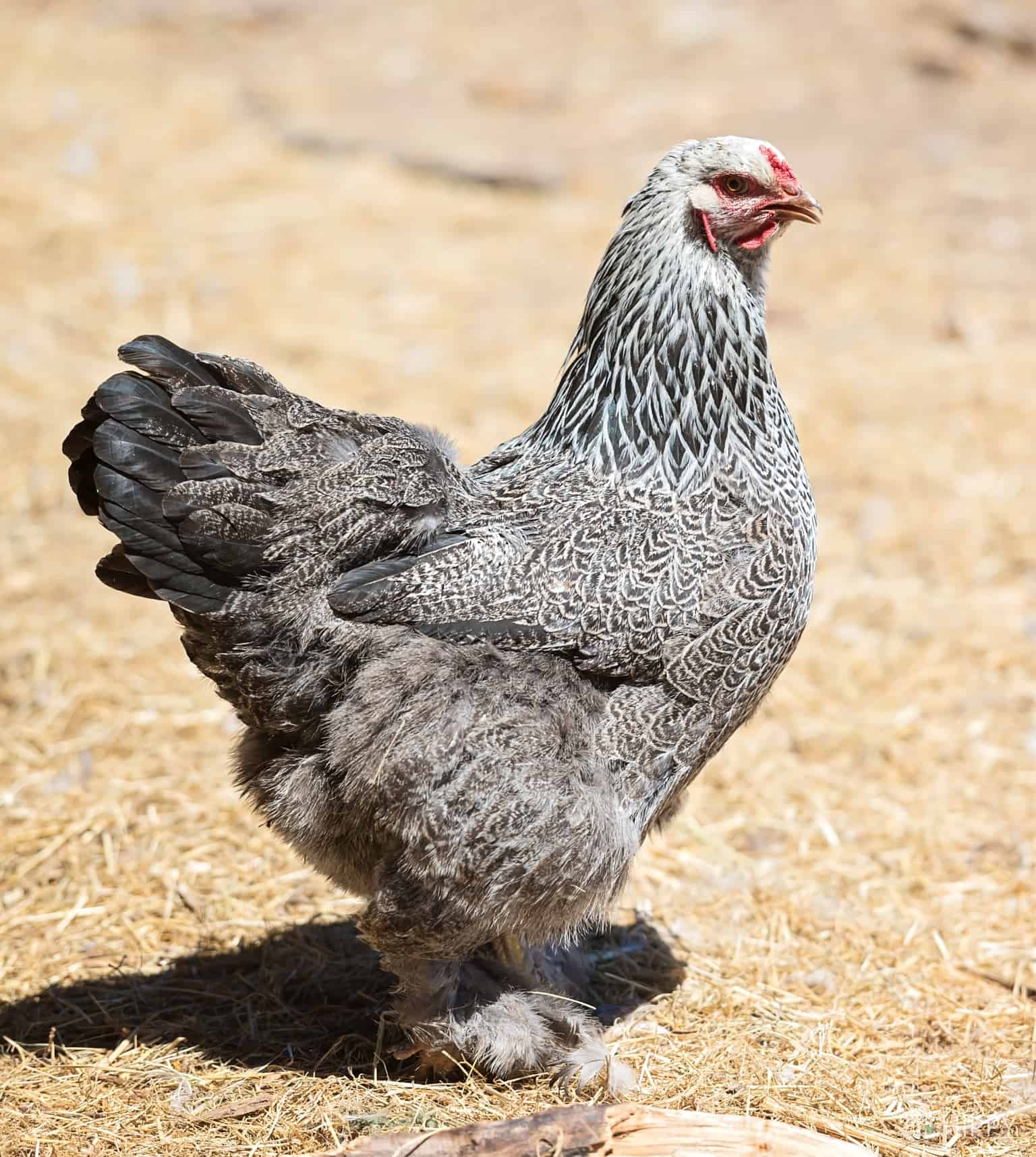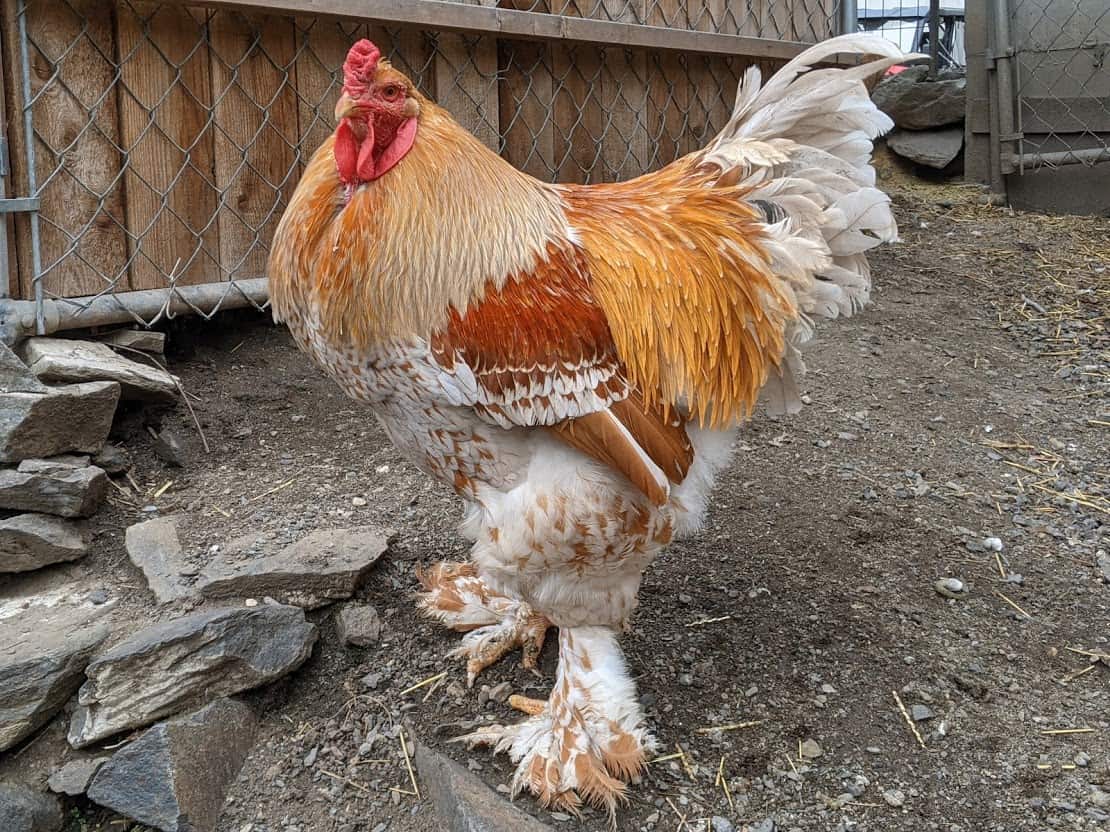Unveiling The Majestic Brahma Chicken: Breed Guide & Care Tips
Is the Brahma chicken truly the "King of All Poultry," as it's often touted? The Brahma chicken, with its imposing size, feathered legs, and gentle demeanor, has captivated poultry enthusiasts for over a century, establishing itself as a breed of both striking beauty and practical purpose.
Originating in the United States from stock imported from China via the port of Shanghai, the Brahma quickly became a popular breed, prized for its dual-purpose capabilities. These birds excel as both meat producers and egg layers, and their impressive size allows them to thrive even in colder climates. While their popularity has waxed and waned over the years, the Brahma chicken continues to hold a special place in the hearts of poultry keepers worldwide. The story of the Brahma is not just about a chicken; its a tale of cross-continental trade, Victorian-era fascination, and the enduring appeal of a bird that seamlessly blends beauty with utility.
| Attribute | Details |
|---|---|
| Origin | United States (Developed from stock imported from China) |
| Type | Heavy Breed, Dual-Purpose (Meat and Eggs) |
| Size | Large; Roosters can weigh up to 18 pounds, hens up to 12 pounds |
| Appearance | Large frame, heavily feathered legs and feet, pea comb, variety of colors including Light, Dark, and Buff |
| Temperament | Generally docile and friendly, making them suitable for families |
| Egg Laying | Moderate layer of brown eggs, typically around 150-200 eggs per year |
| Climate Tolerance | Excellent cold weather hardiness due to their size and feathering |
| Meat Quality | Excellent meat production due to their size, offering a substantial amount of high-quality meat |
| Care Requirements | Requires a spacious coop and run due to their size; benefit from dry, clean environment |
| Notable Characteristics | Feathered shanks and toes, impressive size, gentle disposition, diverse color variations |
| Lifespan | Typically 5-8 years |
| Reference Website | Backyard Chickens - Brahma Breed Information |
The Brahma chickens journey began in the mid-19th century. American poultry enthusiasts, eager to improve their flocks, began importing birds from various parts of the world. The exact origins of the Brahma are somewhat debated, but its widely accepted that they were developed from large, Asiatic fowls, primarily the Shanghai, and possibly contributions from Gray Chittagongs. These birds, characterized by their immense size and distinctive plumage, were crossed and selectively bred to produce the Brahma we know today.
The Brahma's arrival coincided with a surge in popularity for poultry keeping in America, spurred by factors such as increased urbanization and the desire for a readily available food source. The Brahmas size was a significant advantage, allowing for a larger yield of meat compared to other breeds. Their ability to lay a respectable number of eggs, even during the colder months, further solidified their appeal. This dual-purpose functionality made them invaluable to homesteaders and farmers alike.
One of the most striking features of the Brahma is its imposing physique. Roosters can reach weights of up to 18 pounds, while hens typically weigh around 12 pounds. This considerable size, combined with their profuse feathering, particularly on their legs and toes, gives them a regal appearance. The pea comb, another distinguishing characteristic, is well-suited to colder climates, as its compact shape is less susceptible to frostbite.
Brahmas come in a variety of color patterns, with Light Brahmas, Dark Brahmas, and Buff Brahmas being the most commonly recognized. Light Brahmas feature a white body with black markings in the hackle, wing, and tail feathers. Dark Brahmas exhibit a more intricate pattern, with the roosters displaying a striking combination of black and silver, while the hens are often dark gray with penciling. Buff Brahmas are a more uniform golden-buff color.
Beyond their aesthetic appeal, Brahmas are renowned for their gentle and docile temperament. They are generally friendly birds, making them a good choice for families with children. They tend to be calm and tolerate confinement well, although they do require ample space due to their size. Their easygoing nature also makes them less prone to aggressive behaviors, minimizing conflicts within the flock.
The Brahma's practicality extends beyond its meat production and amiable disposition. They are exceptionally hardy birds, particularly well-suited to cold climates. Their dense feathering provides excellent insulation, and their feathered legs and toes help protect them from frostbite. This resilience makes them a popular choice in regions with harsh winters, where other breeds might struggle.
While Brahmas are not prolific egg layers compared to some modern hybrid breeds, they do produce a reasonable number of eggs. A healthy Brahma hen can lay around 150 to 200 medium to large brown eggs per year. This consistent, if not extraordinary, egg production, combined with their meat-producing capabilities, solidified their status as a valuable dual-purpose breed.
Caring for Brahma chickens requires some specific considerations due to their size. They need a spacious coop and run to accommodate their large frames and prevent overcrowding. Adequate ventilation is crucial to avoid respiratory problems, and the coop should be kept clean and dry. Because of their feathered feet, they benefit from dry litter to prevent issues like foot rot. The coop design should include low roosting bars, as Brahmas can be clumsy and may injure themselves if they fall from a height.
The Brahma's dietary needs are relatively standard for chickens. They should be provided with a high-quality feed formulated for large fowl, ensuring they receive adequate protein for growth and egg production. Access to fresh water is essential, and supplemental treats like kitchen scraps, grains, and greens can be offered in moderation. They are not particularly active birds, so overfeeding should be avoided to prevent obesity.
The Brahma's legacy extends far beyond its practical contributions to agriculture. In the Victorian era, the breed became a symbol of status and refinement. Poultry shows and competitions became popular, and Brahmas were highly prized for their size, beauty, and impressive plumage. They were frequently featured in illustrations and publications, solidifying their place in popular culture.
The breed's popularity continued into the early 20th century, but it faced competition from newer, more specialized breeds. The development of commercial hybrid layers, optimized for egg production, and meat-producing breeds with faster growth rates, challenged the Brahma's dominance. The Brahma's dual-purpose nature, however, continued to appeal to those seeking a more balanced approach to poultry keeping.
Today, the Brahma remains a beloved breed, cherished by hobbyists, small-scale farmers, and backyard chicken enthusiasts. Their impressive size, striking appearance, and gentle nature make them a rewarding addition to any flock. They represent a connection to a bygone era of poultry keeping, when functionality and beauty were equally valued.
Maintaining the Brahma breed requires careful breeding practices. Preserving their genetic diversity is important to prevent inbreeding and maintain the breed's vigor. Selecting birds with desirable traits, such as good health, egg production, and conformation to breed standards, is crucial for ensuring the continued success of the Brahma.
The future of the Brahma chicken is secure as long as people appreciate its unique qualities. Its status as a heritage breed ensures its continued presence in poultry shows and small farms. The Brahma provides a living link to the history of poultry keeping, reminding us of the enduring appeal of a bird that combines practicality with aesthetic appeal. Their legacy is a testament to the power of selective breeding and the enduring allure of a truly magnificent fowl.
Beyond the standard care practices, owners need to be vigilant for potential health issues. While generally hardy, Brahmas, like all chickens, are susceptible to parasites such as mites and lice. Regular inspections and appropriate preventative measures are essential. Ensuring proper sanitation within the coop and run is important to avoid the spread of diseases. Brahmas can also be prone to leg problems due to their size, so maintaining a healthy weight and providing adequate space for movement are key.
The Brahma chicken is more than just a breed; it's a living piece of history. Its story reflects the evolving relationship between humans and poultry, from the early days of cross-continental trade to the modern-day backyard flock. Their enduring appeal underscores the value of breeds that offer a blend of utility and aesthetic charm. The Brahma continues to thrive because it embodies a timeless quality, combining substance with style.
The impact of the Brahma chicken on the poultry industry is significant. It contributed to the development of other breeds, particularly those with a focus on size and hardiness. Its presence in poultry shows and competitions has helped shape the standards and expectations for large fowl. Their influence can still be seen in the modern chicken breeds and their ongoing popularity within the poultry community. The Brahma chickens impact is visible in the historical record and is still relevant today.
The Brahma chicken's continued presence in the world of poultry keeping serves as a reminder of the rich diversity and heritage of domestic fowl. It stands as a living symbol of adaptability, reflecting how carefully chosen characteristics can create an enduring and practical bird. The story of the Brahma is a testament to the enduring allure of a breed that balances beauty, purpose, and history.
In the world of poultry, the Brahma stands out as a breed of remarkable stature. Its imposing size, feathered legs, and gentle temperament combine to create a truly impressive bird. They're a breed that successfully merges utility with aesthetic appeal, providing both meat and eggs. The Brahma chicken remains a favorite among poultry enthusiasts everywhere.

Brahma Chicken Breed What You Need to Know

Brahma Chickens All You Need to Know About Them

Brahma Chicken Appearance, Eggs, Size and Raising Tips